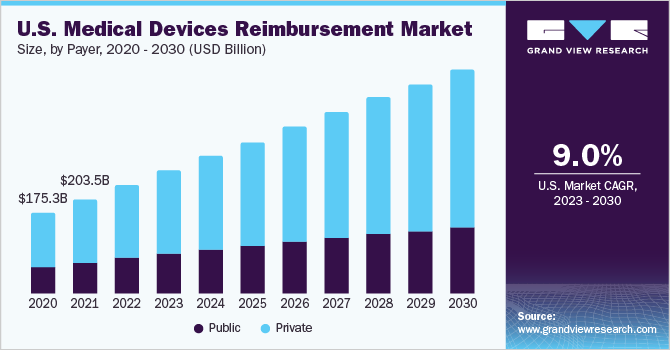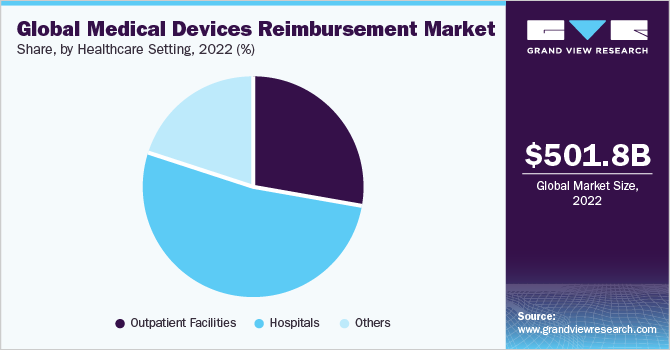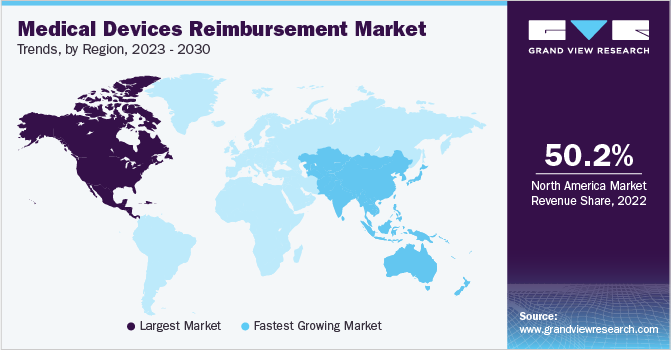- Home
- »
- Medical Devices
- »
-
Medical Devices Reimbursement Market Size Report, 2030GVR Report cover
![Medical Devices Reimbursement Market Size, Share & Trends Report]()
Medical Devices Reimbursement Market Size, Share & Trends Analysis Report By Payer (Public, Private), By Healthcare Setting (Hospitals, Outpatient Facilities), By Region, And Segment Forecasts, 2023 - 2030
- Report ID: GVR-4-68038-835-0
- Number of Report Pages: 275
- Format: PDF, Horizon Databook
- Historical Range: 2018 - 2021
- Forecast Period: 2022 - 2030
- Industry: Healthcare
Report Overview
The global medical devices reimbursement market size was estimated at USD 501.8 billion in 2022 and is anticipated to grow at a compound annual growth rate (CAGR) of 8.8% from 2023 to 2030. Medical device reimbursement is defined as the payment a private insurer pays to healthcare providers for costs the provider incurred while using medical devices. Usually, the health insurer or government payers cover the patients’ healthcare expenses inclusive of medical device use. Technological advancements in Electronic Medical Records (EMR), rising cases of chronic diseases, and the growing need for reimbursement are certain factors driving the market.

During the COVID-19 pandemic, the demand for remote monitoring increased and now various public organizations like Medicare are providing reimbursement for remote monitoring. Remote monitoring has gained significant importance in treating patients with chronic diseases. The high burden of chronic diseases is expected to improve the demand for remote monitoring in the coming years and this is anticipated to have a positive impact on market growth.
The U.S. Affordable Care Act focuses on decreasing the costs of healthcare for patients. The main purpose of this act is to reduce medical device costs and make affordable healthcare insurance available to every person in the country. In addition, the Center for Medicaid and Medicare is working toward providing high-quality medical devices and making health insurance available for billions of people. Medicaid spending in the U.S. increased by 9.2% in 2021. Also, according to a report published by the American Medical Association, USD 4.3 trillion is estimated to have been spent on healthcare reimbursement in 2021 in the U.S.
With an increasingly aging population, healthcare expenditures will continue to increase, leading to high demand for medical devices. This is another factor that will highly impact the reimbursement industry in the long run. Other factors responsible for the growth of the market are the increasing cost of healthcare, the growing patient population, and rising awareness among people regarding health insurance policies.
Governments from various countries are providing an add-on reimbursement for medical devices post-COVID-19 pandemic. For instance, in May 2022, the French National Authority for Health provided certain recommendations for adding reimbursement on medical devices such as diagnostic imaging devices, cardiovascular and peripheral vascular devices, and interventional radiology devices. Such actions by the government are expected to support the growth of the market in the coming years.
Payer Insights
The private payer segment accounted for the largest revenue share of around 65.0% in 2022 and is expected to grow at the fastest CAGR during the forecast period. The growth of the segment is attributed to the presence of a large number of private players in the market. The rising prevalence of cancer and diabetes and increasing demand for better treatment are responsible for segment growth over the forecast period. Private players reimburse a medical device that has been approved by the FDA. Also, with the increasing prevalence of respiratory diseases, the demand for expensive medical devices, such as ventilators, is increasing. Therefore, the demand for private payer services is expected to grow over the forecast period.
The public payer segment is expected to expand at a CAGR of 7.6% over the forecast period. Public payers provide end-to-end solutions to companies in the pharmaceutical and healthcare industries. Consequently, the demand for public payers is increasing due to the increasing prevalence rate of chronic diseases globally and the need for cost-effective procedures in healthcare settings. An increase in the adoption of public payer services in emerging and developed markets and the introduction of advanced medical devices along with reimbursement facilities are among the major factors contributing to the segment growth.
Healthcare Setting Insights
The hospitals segment accounted for the largest revenue share of 51.8% in 2022. The growing prevalence of chronic diseases is driving the demand for medical device reimbursement in large-scale settings such as hospitals. Many research-based innovative medical devices are initially used in public hospitals before they are sold to private hospitals. The private healthcare settings maintain a purchasing budget, which includes surplus revenue being extracted from patients directly. Hence, they are more equipped with state-of-the-art medical devices.

The outpatient facilities segment is expected to grow at the fastest CAGR of 9.2% during the forecast period due to the increasing investments in R&D and the growing incidence of chronic diseases. Moreover, the growing need for medicines and their cost-efficient production is anticipated to further drive the segment. In addition, these standalone practices provide special health packages (inclusive of various services, such as preventive assessment, customized travel care, and genetic testing) for corporate firms and their employees, thus boosting segment growth.
Regional Insights
North America dominated the market and accounted for the largest revenue share of 50.2% in 2022 owing to favorable regulatory policies and robust reimbursement structure. Provisions for medical device reimbursement are also well-established in the region. The rising prevalence of chronic diseases, coupled with the increasing demand for medical devices, is expected to augment market growth in this region over the forecast period.

Asia Pacific is expected to grow at the fastest CAGR of 9.3% during the forecast period due to rising healthcare expenditure, increasing chronic disease prevalence, and rising demand for resources in developing countries like China, Japan, South Korea, and India. These countries are adopting the policies being followed by the U.S. and European countries to streamline and develop a highly efficient healthcare management system, which is likely to have a positive impact on market growth. In January 2023, Bajaj Allianz General Insurance announced the introduction of their modular health insurance product 'My Health Care Plan'. The program includes mandatory coverages such as in-patient hospitalization costs, before and post-hospitalization costs, modern treatment methods, and others.
Key Companies & Market Share Insights
Key companies are focusing on R&D to introduce technologically advanced products and gain a competitive edge. Growth in medical device reimbursement will, in turn, propel technological advancements by medical device manufacturers. This will allow for better healthcare outcomes and higher cost efficiency in the long run. The medical device players are investing in consulting toward the preparation of apt reimbursement proposals for regulatory authorities to increase their profit margins. This trend is expected to rise owing to reimbursement being the biggest challenge for medical device manufacturers to secure coverage and attract risk-averse investors.
In North America, the most prominent region for this market, since the implementation of the Affordable Care Act, the healthcare industry has transformed from a volume-based to a value-based care model, thus driving the need for reimbursement consulting. Key companies are also engaging in partnerships, mergers, and acquisitions to strengthen their product portfolio, expand manufacturing capacities, and provide competitive differentiation. In May 2023, Humana Inc. announced that it entered into an agreement with Rotech Healthcare Inc. and AdaptHealth Corp. to deliver Durable Medical Equipment services to Humana Medicare Advantage HMO enrollees to help them achieve the best health at home. Some prominent players in the global medical devices reimbursement market include:
-
Aviva
-
Nippon Life Insurance
-
CVS Health
-
WellCare Health Plans, Inc.
-
BNP Paribas
-
Allianz
-
Humana Inc.
-
Cigna
-
UnitedHealth Group
-
Anthem Insurance Companies, Inc.
Medical Devices Reimbursement Market Report Scope
Report Attribute
Details
Market size value in 2023
USD 570.0 billion
Revenue forecast in 2030
USD 1,028.2 billion
Growth rate
CAGR of 8.8% from 2023 to 2030
Base year for estimation
2022
Historical data
2018 - 2021
Forecast period
2023 - 2030
Report updated
September 2023
Quantitative units
Revenue in USD million/billion and CAGR from 2023 to 2030
Report coverage
Revenue forecast, company ranking, competitive landscape, growth factors, and trends
Segments covered
Payer, healthcare setting, region
Regional scope
North America; Europe; Asia Pacific; Latin America; MEA
Country scope
U.S.; Canada; U.K.; Germany; France; Italy; Spain; Denmark; Sweden; Norway; China; Japan; India; Australia; South Korea; Thailand; Brazil; Mexico; Argentina; Saudi Arabia; South Africa; UAE; Kuwait
Key companies profiled
Aviva; Nippon Life Insurance; CVS Health; WellCare Health Plans, Inc.; BNP Paribas; Allianz; Humana Inc.; Cigna; UnitedHealth Group; Anthem Insurance Companies, Inc.
Customization scope
Free report customization (equivalent up to 8 analyst’s working days) with purchase. Addition or alteration to country, regional & segment scope
Pricing and purchase options
Avail customized purchase options to meet your exact research needs. Explore purchase options
Global Medical Devices Reimbursement Market Report Segmentation
This report forecasts revenue growth at global, regional, and country levels and analyzes the latest industry trends in each of the sub-segments from 2018 to 2030. For this study, Grand View Research has segmented the global medical devices reimbursement market report based on payer, healthcare setting, and region:

-
Payer Outlook (Revenue, USD Million, 2018 - 2030)
-
Public
-
Private
-
-
Healthcare setting Outlook (Revenue, USD Million, 2018 - 2030)
-
Hospitals
-
Outpatient facilities
-
Others
-
-
Regional Outlook (Revenue, USD Million, 2018 - 2030)
-
North America
-
U.S.
-
Canada
-
-
Europe
-
UK
-
Germany
-
France
-
Italy
-
Spain
-
Sweden
-
Norway
-
Denmark
-
-
Asia Pacific
-
China
-
Japan
-
India
-
Australia
-
Thailand
-
South Korea
-
-
Latin America
-
Brazil
-
Mexico
-
Argentina
-
-
Middle East and Africa
-
Saudi Arabia
-
South Africa
-
UAE
-
Kuwait
-
-
Frequently Asked Questions About This Report
b. The global medical devices reimbursement market size was estimated at USD 501.8 billion in 2022 and is expected to reach USD 570.0 billion in 2023.
b. The global medical devices reimbursement market is expected to grow at a compound annual growth rate of 8.8% from 2023 to 2030 to reach USD 1,028.2 billion by 2030.
b. Private payers dominated the medical device reimbursement market in 2022. They are estimated to remain dominant throughout the forecast horizon owing to the fact that a large number of private players are present in the market.
b. Some key players operating in the medical devices reimbursement market include Aviva, Nippon Life Insurance, CVS Health, WellCare Health Plans, Inc., BNP Paribas, Allianz, Humana Inc., Cigna, UnitedHealth Group, and Anthem Insurance Companies, Inc.
b. Key factors driving the medical devices reimbursement market growth include increased cost of devices, enhanced strategic planning on part of medical device manufacturers, the introduction of reforms and new bills by governments, and shift of healthcare providers to form accountable care organizations (ACOs).
Share this report with your colleague or friend.
![gvr icn]()
NEED A CUSTOM REPORT?
We can customize every report - free of charge - including purchasing stand-alone sections or country-level reports, as well as offer affordable discounts for start-ups & universities. Contact us now
![Certified Icon]()
We are GDPR and CCPA compliant! Your transaction & personal information is safe and secure. For more details, please read our privacy policy.
We are committed towards customer satisfaction, and quality service.
"The quality of research they have done for us has been excellent."





